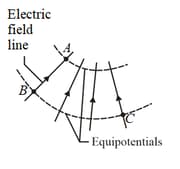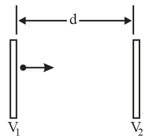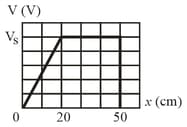If a proton moves through a potential difference of what is the magnitude of the change in the proton's potential energy expressed in the unit electron-volt?

Important Questions on Electric Potential
In Fig. (a), a particle of elementary charge is initially at coordinate on the dipole axis (here a axis) through an electric dipole, on the positive side of the dipole. (The origin of is at the center of the dipole.) The particle is then moved along a circular path around the dipole center until it is at coordinate on the negative side of the dipole axis. Figure (b) gives the work done by the force moving the particle versus the angle $\theta$ that locates the particle relative to the positive direction of the axis. The scale of the vertical axis is set by . What is the magnitude of the dipole moment?


(a) (b)
When an electron moves from to along an electric field line in figure. The electric field does of work on it. What are the electric potential differences (a) (b) and (c)

In Figure, a charged particle (either an electron or a proton) is moving rightward between two parallel charged plates separated by distance The plate potentials are and . The particle is slowing from an initial speed of at the left plate.
(a) Is the particle an electron or a proton?
(b) What is its speed just as it reaches the plate

A positron (charge mass equal to the electron mass) is moving at in the positive direction of an -axis when, at it encounters an electric field directed along the -axis. The electric potential associated with the field is given in the figure. The scale of the vertical axis is set by (a) Does the positron emerge from the field at (which means its motion is reversed) or at (which means its motion is not reversed)? (b) What is its speed when it emerges?

Suppose electrons can be placed in either of two configurations. In configuration they are all placed on the circumference of a narrow ring of radius and are uniformly distributed so that the distance between adjacent electrons is the same everywhere. In configuration electrons are uniformly distributed on the ring and one electron is placed in the center of the ring.
(a) What is the smallest value of for which the second configuration is less energetic than the first?
(b) For that value of considering anyone circumference electron, call it How many other circumference electrons are closer to than the central electron is?
The smiling face of the given figure consists of three items:
1. A thin rod of charge that forms a full circle of radius .
2. A second thin rod of charge that forms a circular arc of radius subtending an angle of about the centre of the full circle.
3. An electric dipole with a dipole moment that is perpendicular to a radial line and has a magnitude of .
What is the net electric potential at the centre?

